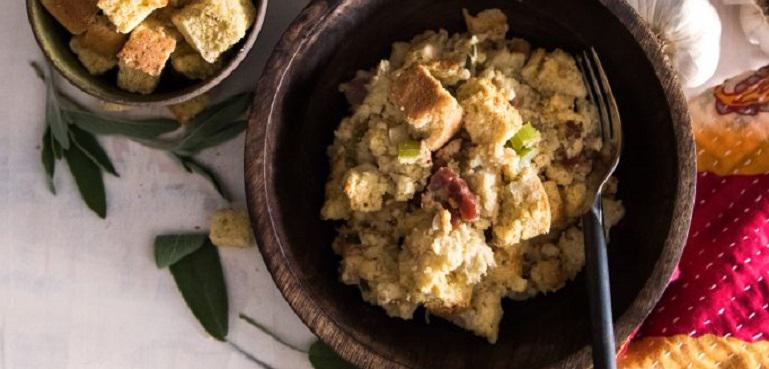


 Searching for a way to use chives in your next meal? Whip up a large batch of this 13 Bean Chili Recipe. Delicious and simple to make, this chili uses seasonal spices and herbs like chives to create a savory and warming dish perfect for chilly fall nights. For an even more filling meal, serve this chili with a side of homemade cornbread. Everyone who takes a bite is sure to love it!
Searching for a way to use chives in your next meal? Whip up a large batch of this 13 Bean Chili Recipe. Delicious and simple to make, this chili uses seasonal spices and herbs like chives to create a savory and warming dish perfect for chilly fall nights. For an even more filling meal, serve this chili with a side of homemade cornbread. Everyone who takes a bite is sure to love it!
 Searching for an autumn dessert recipe? Make these Rosemary Lemon Tarts with Toasted Meringue. This dessert features flaky tart shells spiked with fresh rosemary and filled with zesty lemon curd. Topped with toasted meringue, they're the perfect dessert to bring to your next holiday get-together, pair with tea or make for a special occasion at home.
Searching for an autumn dessert recipe? Make these Rosemary Lemon Tarts with Toasted Meringue. This dessert features flaky tart shells spiked with fresh rosemary and filled with zesty lemon curd. Topped with toasted meringue, they're the perfect dessert to bring to your next holiday get-together, pair with tea or make for a special occasion at home.
 When added to dishes, sage brings warmth and complexity that is unmatched by any other herb. For a holiday stuffing that your family will come racing to the table to eat, make this Bacon and Sage Cornbread Stuffing. Made with our Gluten Free Cornbread Mix, it's a classic recipe that tastes great when accompanied by seasonal sides.
When added to dishes, sage brings warmth and complexity that is unmatched by any other herb. For a holiday stuffing that your family will come racing to the table to eat, make this Bacon and Sage Cornbread Stuffing. Made with our Gluten Free Cornbread Mix, it's a classic recipe that tastes great when accompanied by seasonal sides.
 Rice pilaf is one of the most comforting plates to make during the fall. A warming and filling dish, it's the ideal side to pair with lean proteins and meats. Additionally, rice pilaf can be used as a filling when stuffing bell peppers, mushrooms and even pumpkin. To make this savory rice pilaf, fresh parsley, onion and carrot are finely chopped and mixed into the recipe to provide the perfect balance of tasty flavors.
Rice pilaf is one of the most comforting plates to make during the fall. A warming and filling dish, it's the ideal side to pair with lean proteins and meats. Additionally, rice pilaf can be used as a filling when stuffing bell peppers, mushrooms and even pumpkin. To make this savory rice pilaf, fresh parsley, onion and carrot are finely chopped and mixed into the recipe to provide the perfect balance of tasty flavors.
 Who doesn't love cookies? Especially in the fall. If you're searching for the perfect light and refreshing cookie to snack on throughout your day, then try out this Almond Lavender Biscotti Cookie Recipe. A light and delicate flavor, these cookies are perfect when paired with tea or coffee. Enjoy them as a sweet breakfast cookie or as an afternoon treat. When you choose to snack on these cookies, we know that it will add a bit of sweetness to your day.
Get set for fall by filling your weekly menu with herb-infused dishes that are both delicious and impressive. Whether you're a pro at cooking with herbs or just starting, this list of five autumn herbs to use this season will ensure that you always feel prepared. From lavender to chives, the herbs on this list are loaded with flavor and culinary surprises. When the leaves begin to fall, and a cool breeze fills the air, try out some of the recipes on this list that showcase autumn's best flavors.
Have a favorite fall herb you think we should know about? We'd love to hear about it. Let us know the different herbs you stay stocked up on in the comments below. From everyone at Bob's Red Mill, happy holidays!
Who doesn't love cookies? Especially in the fall. If you're searching for the perfect light and refreshing cookie to snack on throughout your day, then try out this Almond Lavender Biscotti Cookie Recipe. A light and delicate flavor, these cookies are perfect when paired with tea or coffee. Enjoy them as a sweet breakfast cookie or as an afternoon treat. When you choose to snack on these cookies, we know that it will add a bit of sweetness to your day.
Get set for fall by filling your weekly menu with herb-infused dishes that are both delicious and impressive. Whether you're a pro at cooking with herbs or just starting, this list of five autumn herbs to use this season will ensure that you always feel prepared. From lavender to chives, the herbs on this list are loaded with flavor and culinary surprises. When the leaves begin to fall, and a cool breeze fills the air, try out some of the recipes on this list that showcase autumn's best flavors.
Have a favorite fall herb you think we should know about? We'd love to hear about it. Let us know the different herbs you stay stocked up on in the comments below. From everyone at Bob's Red Mill, happy holidays!